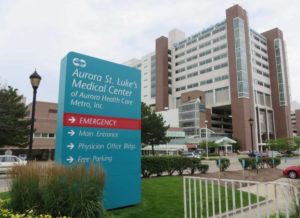Over the past five years, doctors at Aurora St. Luke’s Medical Center in Milwaukee have been impressed by the results of a new, minimally-invasive surgical technique they developed to treat a condition that causes heartbeat irregularities.

The condition, a common type of heart arrhythmia called atrial fibrillation, causes the heart to pump too quickly, too slowly or at irregular intervals. It quadruples the risk of stroke and heart failure and it’s a life-long condition that gradually worsens over time.
So far, the results of the new technique have been promising. One year after receiving the surgery, 85 percent of atrial fibrillation-affected hearts are still beating regularly, which is on par with results of traditional thoracoscopic surgeries, but with far fewer post-operation complications and much less time spent in the hospital.
The doctors who pioneered the technique at Aurora, Dr. David Kress and Dr. Jasbir Sra are now preparing to share it with doctors from hospitals around the world.
“So far I’ve mostly just been giving lectures, but we’re setting up a program where other hospitals can actually come to St. Luke’s and we can show them exactly how we set it up,” Kress said.”We’re right in the process of starting this now.”
Kress is the chief of Cardiothoracic Surgery at St. Luke’s. Sra is the medical director of Aurora’s Atrial Fibrillation Ablation Center. Together, the two combined separate procedures used to correct the arrhythmia into a single surgery.
A traditional thoracoscopic surgery to correct atrial fibrillation takes about 4 hours. Afterward, patients are usually hospitalized for six or seven days and an average of 13 percent of them experience some form of post-surgery complication.
The hybrid approach pioneered at St. Luke’s takes about 90 minutes and requires two to three days of hospitalization. Only 4 percent of patients treated with the hybrid approach experience complications.
Here’s how it works: an electrophysiologist and cadiothoracic surgeon create scar tissue to block damaged electrical pathways on the exterior and interior of the heart that cause it to beat irregularly.
Kress said doctors make a small, two-centimeter incision, pass over the liver and go through the diaphragm to get to the heart.
“Patients are in the hospital for two to three days and they end up with a Band-Aid,” Kress said. “That compares to other centers where they go in through the ribs … it’s a very complicated technique and there’s a fair amount of pain that goes along with it as well.”
Aurora doctors have monitored around 130 patients who underwent either the new hybrid surgery or a traditional thoracoscopic surgery since 2010.
After five years, 65 percent of patients who received the hybrid surgery were still beating at a regular rhythm, compared to 45 percent of those who received the thoracoscopic surgery.
“That’s fantastic,” Kress said. “Obviously, this is a lifelong condition, so there are patients who eventually will get AFib again.”
But in the meantime, he said, the surgery has achieved better long-term results and improved quality of life for patients.
Each year, atrial fibrillation results in more than 750,000 hospitalizations and contributes to more than 130,000 deaths, according to the Centers for Disease Control and Prevention.